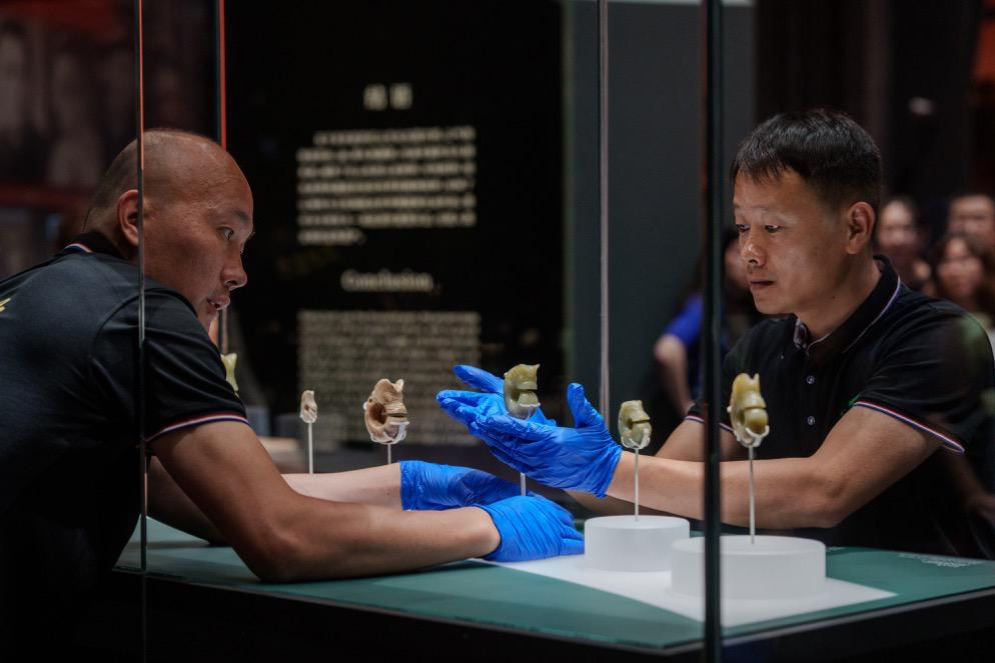Migrating cranes pause in China


Birds feed a hatchling in the reserve.
Bird-watchers in Shanghai flock to see wonders of Mother Nature
Every year's end, Yao Li makes the two-hour drive to Shanghai's Chongming Island to meet old friends. He never speaks with them, and he never joins them in activities. After all, Yao cannot fly.
Shanghai is one of the stops in the migratory flyway from Siberia to Australia, and the Chongming Dongtan National Nature Reserve is the largest wintering site in China. Every year, about 1,000 hooded cranes stop in China, and some can be spotted making their way to the reserve from October to December, Yao said.
"Awaiting the arrival of migratory birds is like expecting a group of old friends who return home at the same time every year," the 45-year-old information technology professional said.
"I love the way the birds are when they are free in nature, be it flying or standing on a tree branch."
Established in 1998, the reserve is host to about 1 million migratory birds every year. Apart from authorized personnel, no bird-watchers or photographers are allowed in the area. According to official data, about 290 bird species have been spotted there. Among the main waterfowl species that winter in the reserve are cranes, herons, ducks, shorebirds and gulls.
Besides the nature reserve, Chongming Island is also home to an assortment of natural parks, wetlands and ecological villages where people can watch birds. After completion of the island's development master plan for 2017-35, Chongming will become a world-class ecological zone by 2050, setting a new bench mark in the protection of the ecological system along the Yangtze River.
The island is currently one of the country's top destinations for bird-watchers.
Wang Huo, deputy secretary-general of the China Biodiversity Conservation and Green Development Foundation and a member of the International Union for Conservation of Nature's species survival commission, said bird-watching and photography are important civic science activities that provide valuable information for the conservation of birds and their ecological environment.
She said there are many other popular bird-watching spots in the country. For example, hundreds of spoonbill sandpipers-an endangered species with no more than 500 left in the world-spend up to three months in the wetlands of Jiangsu province's Dongtai county every year.
"Bird-watchers and photographers are an important group of people because they play a part in monitoring the bird population and protecting habitats," Wang said.
The popularity of birdwatching in Shanghai has been on the rise. In April 2005, just 82 people in 14 teams took part in the local bird-watching contest. This year, 300 birdwatchers in 35 teams attended the event.

Tim Hirsch, deputy director-general of the Global Biodiversity Information Network, once said that the bird-watching scene in China includes more young people than in Europe or the United States. He said that while bird-watching started in Western countries in the late 19th century, it is still relatively new to China and thus comes across as a novel activity that appeals to the younger generation.
Besides Chongming Island, there are several other birdwatching spots in Shanghai, including the Shanghai Botanical Garden and Century Park, where people can view species including sparrows, the bald bulbul and the red falcon.

According to a survey of the bird population in four Shanghai parks, 162 species were found between 2008 and 2012.
More than 80 percent of the birds found in the parks are arboreal, meaning they spend most of the time in trees.
Zhang Bin, a wildlife photographer who has been working as a research volunteer at the Chongming Dongtan National Nature Reserve since 2002, recalled how people once hunted the migrating birds on the island, trapping them with nets along the coast and killing them for food.
However, the construction of protected areas such as the nature reserve and the implementation of enforcement measures has greatly improved the environment for migratory birds, he added. In addition, officials have been cooperating with wildlife experts for the past six years to determine how the natural conditions can be improved.
- Report offers insight into studying in New Zealand
- Former head of China's National Administration of Traditional Chinese Medicine under probe
- Actress accused of 'faking' records to take?gaokao
- Beijing urges public to take precautions amid lingering heatwave
- High-performance invasive brain-computer interface nears clinical validation stage
- Volunteers for 2025 Summer Davos forum take oath in Tianjin





































